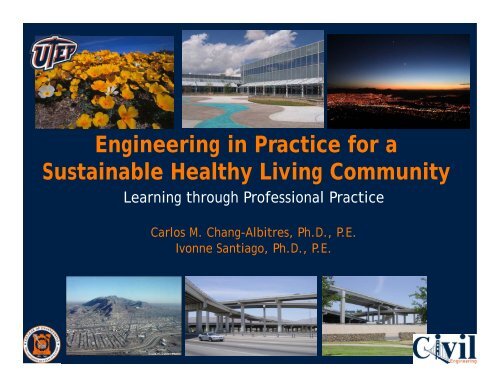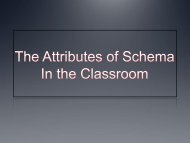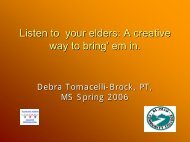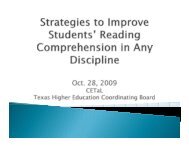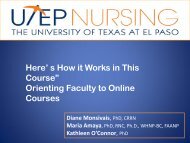HERE - CETaL - University of Texas at El Paso
HERE - CETaL - University of Texas at El Paso
HERE - CETaL - University of Texas at El Paso
Create successful ePaper yourself
Turn your PDF publications into a flip-book with our unique Google optimized e-Paper software.
Engineering in Practice for aSustainable Healthy Living CommunityLearning through Pr<strong>of</strong>essional PracticeCarlos M. Chang-Albitres, Ph.D., P.E.Ivonne Santiago, Ph.D., P.E.
About the Program• Engineering in practice is a program hosted by theCollege <strong>of</strong> Engineering <strong>at</strong> the <strong>University</strong> <strong>of</strong> <strong>Texas</strong> <strong>at</strong> <strong>El</strong><strong>Paso</strong> (UTEP) to foster best engineering practices.• The pilot program began <strong>at</strong> the Department <strong>of</strong> CivilEngineering Fall 2010.• Supports activities both <strong>at</strong> the undergradu<strong>at</strong>e andgradu<strong>at</strong>e level th<strong>at</strong> connect pr<strong>of</strong>essional practice andeduc<strong>at</strong>ion.
Why this Program?• The need <strong>of</strong> having engineers who are aware <strong>of</strong>on-going changes in the economic, social, andenvironmental conditions has increased in a worldth<strong>at</strong> is constantly evolving.• Address multidisciplinary engineering challenges.Engineering in practice = Engineering in service
Other Objectives• To merge educ<strong>at</strong>ion, research, and pr<strong>of</strong>essionalpractice with a team composed <strong>of</strong> faculty, gradu<strong>at</strong>eand undergradu<strong>at</strong>e students to work with pr<strong>of</strong>essionalengineers.• To propose solutions to engineering problems th<strong>at</strong>pose a thre<strong>at</strong> for a healthy living community.
Expected Outcomes• To transfer pr<strong>of</strong>essional knowledge accumul<strong>at</strong>edthrough years <strong>of</strong> practice to the students.• To increase student’s awareness th<strong>at</strong>engineering problems need to be understoodunder their own decision-making context.
How to Join the Program?• Students should identify an expert group <strong>of</strong>interest and contact the coordin<strong>at</strong>or to look fortopics.• Faculty members interested in developing orjoining an expert group.• Pr<strong>of</strong>essional engineers who have identified aspecific problem <strong>of</strong> interest can contact the expertgroup coordin<strong>at</strong>or to join the program.
Expert Groups• Expert groups will addressdifferent types <strong>of</strong>engineering challenges for asustainable healthy livingcommunity.• The expert group will includeundergradu<strong>at</strong>e and gradu<strong>at</strong>estudents, faculty members,and pr<strong>of</strong>essional engineersfrom sponsor organiz<strong>at</strong>ions.• Construction Techniques• EnvironmentalEngineering• Infrastructure• Innov<strong>at</strong>ive M<strong>at</strong>erials• Pavements• Transport<strong>at</strong>ion Systems• W<strong>at</strong>er ProcessingSystems (Desalin<strong>at</strong>ion,others)
Courses• Undergradu<strong>at</strong>e and gradu<strong>at</strong>e students who are takingthese courses, but not limited to, will be eligible toparticip<strong>at</strong>e in the program.Undergradu<strong>at</strong>e program:• CE 1205 Graphic Fundamentalsin Engineering Design• CE 2341 Economics for Engineersand Scientists• CE 3313 Engineering Measurements*• CE 3336 Engineering M<strong>at</strong>erials• CE 4188 Senior Design I*• CE 4288 Senior Design II*Gradu<strong>at</strong>e curricula:• CE 6195 Civil Engineering Seminar *• CE 6301 Infrastructure Management*• CE 6315 Infrastructure Planning• CE 5324 Construction Management• CE 5310 Risk and Reliability Analysis<strong>of</strong> Engineering Systems* These classes particip<strong>at</strong>ed in EIP in 2011 and 2012
ActivitiesNovember 2012October 2011Roadway Safety by ARTBAApril 2011Asset Management by AgileAssetsFebruary 2011Forgiving Highways by Barrier SystemsBorder Environment Cooper<strong>at</strong>ionCommission Plans and Projects
NCEES Engineering Award• In 2009, NCEES introduced this award torecognize college engineering programs forengaging their students in collabor<strong>at</strong>iveprojects with licensed pr<strong>of</strong>essional engineers.• The NCEES Engineering Award forConnecting Pr<strong>of</strong>essional Practice andEduc<strong>at</strong>ion was established to promoteunderstanding <strong>of</strong> the value <strong>of</strong> licensure and toencourage partnerships between theengineering pr<strong>of</strong>ession and educ<strong>at</strong>ion.
NCEES Awarded Projects• “Development <strong>of</strong> a Sustainable InfrastructureManagement System for the City <strong>of</strong> <strong>El</strong> <strong>Paso</strong>”• “Multidisciplinary Smart Design <strong>of</strong> Fire St<strong>at</strong>ion513”.
2011 and 2012 NCEES Awards20112012
NCEES 2011 AWARD
NCEES 2012 AWARD
Multidisciplinary Smart Design <strong>of</strong> Fire St<strong>at</strong>ion 513Civil Engineering Senior Design Project
Goal• Give the students a real world first-handknowledge <strong>of</strong> how the engineering designworks in a client/consultant environment.
General Description• The design problem was defined in collabor<strong>at</strong>ionwith partners from City government and faculty• Senior Design Capstone Course: One Year/3credit/two Semester project
Minimum Requirements: 1 st Semester• Mentor: Architect• Review Codes and Regul<strong>at</strong>ions• Become familiar with required permitting• Conceptual Design• Floor plan (with dimensions)• Site plan
Conceptual Design
Minimum Requirements• Environmental• Geotechnical• Structural• Construction Management• Transport<strong>at</strong>ion
Environmental Design• LEED• 52 points (loc<strong>at</strong>ion, stormw<strong>at</strong>er management plan,landscaping, and use <strong>of</strong>sustainable m<strong>at</strong>erials,among others).• Surface run <strong>of</strong>f• shallow channels linedwith river rocks leading toseveral smaller decor<strong>at</strong>iveponds.
Geotechnical• Geo-tech analysis• Found<strong>at</strong>ion Design
Structural• Complete structure (beams, columns) andchecks for stresses and deflections
Construction Management• Cost Estim<strong>at</strong>e, schedule for design andconstruction (pre, during, and after)
Transport<strong>at</strong>ion• Traffic flow, curves, parking
Knowledge and skills gained
Student’s Feedback• Biggest challenge faced in the project or EIP programand how it was overcome• R<strong>at</strong>e the EIP program objectives• Knowledge <strong>of</strong> pr<strong>of</strong>essional practice acquired• Knowledge <strong>of</strong> pr<strong>of</strong>essional code <strong>of</strong> ethics• Learn to make an effective oral present<strong>at</strong>ion• Work effectively as a team/group member• Did the EIP program on project experience help youto be prepared to get a job?• Mention the areas th<strong>at</strong> you feel are most important t<strong>of</strong>ocus on the program• Mention wh<strong>at</strong> positive experiences you had by beingpart <strong>of</strong> the project/EIP program
Conclusions• Students are exposed to pr<strong>of</strong>essional practice and researchtechniques and challenged to use all their cre<strong>at</strong>ivity to comeout with practical solutions to real world problems.• Allowed students to learn and develop skills not capable <strong>of</strong>being taught in a classroom:• Pr<strong>of</strong>essional practice and responsibility, leadership, timemanagement, teamwork, and compromise• Faculty members are able to show students the applic<strong>at</strong>ion <strong>of</strong>topics lectured in class and demonstr<strong>at</strong>e how research can beused to develop practical solutions.


